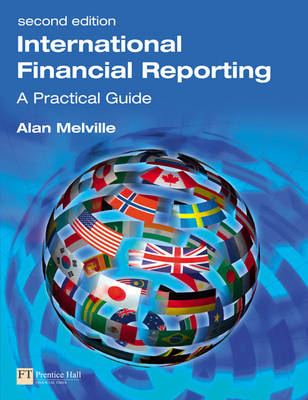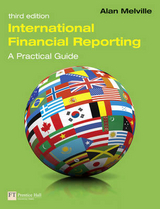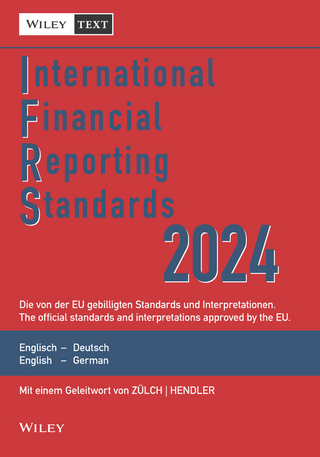
International Financial Reporting
Prentice Hall (Verlag)
978-0-273-73011-8 (ISBN)
- Titel erscheint in neuer Auflage
- Artikel merken
The book provides a unique practical introduction to the international standards, outlining how these standards are used on a daily basis by companies in the preparation of their financial statements. The author examines the recognition, measurement, presentation and disclosure requirements of each IFRS and IAS and every attempt has been made to explain the standards as clearly and concisely as possible.
Examples and practice questions are provided throughout the book to aid student understanding and to provide a framework for grasping the key aspects of this complex and fast-moving subject.
Preface
Acknowledgements
List of international standards
Part 1 INTRODUCTION TO FINANCIAL REPORTING
1 The regulatory framework
The need for regulation
Sources of regulation
Generally accepted accounting practice
The International Accounting Standards Board (IASB)
The standard-setting process
The structure of an internationaL standard
The purpose of accounting standards
Worldwide use of international standards
First-time adoption of international standards
2 The IASB conceptual framework
Purpose and scope of the IASB Framework
Objective of financial statements
Underlying assumptions
Qualitative characteristics of financial statements
Elements of financial statements
Recognition of the elements oF financial statements Measurement of the elements of financial statements Concepts of capital and capital maintenance
3 Presentation of financial statements
Objective of financial statements
Components of financial statements
General features
Structure and content of financial statements
The statement of financial position
The statement of comprehensive income
The statement of changes in equity
The notes to the financial statements
Interim financial reporting
4 Accounting policies, accounting estimates and errors Accounting policies
Accounting estimates
Prior period errors
Part 2 FINANCIAL REPORTING IN PRACTICE
5 Property, plant and equipment
Definition of property, plant and equipment
Recognition of property, plant and equipment
Initial measurement of property, plant and equipment Subsequent measurement of property, plant and equipment
Depreciation
Disclosure requirements
Borrowing costs
Government grants
Investment property
6 Intangible assets
Definition of an intangible asset
Initial recognition and measurement of intangible assets Subsequent measurement of intangible assets
Amortisation of intangible assets
Derecognition
Disclosure requirements
Goodwill
IFRS3 Business Combinations
7 Impairment of assets
Indications of impairment
Recoverable amount
Recognition and measurement of an impairment loss
Cash-generating units
Reversal of impairment losses
Disclosure requirements
8 Non-current assets held for sale and discontinued operations
Classification of non-current assets as held for sale Measurement of non-current assets held for sale Presentation of non-current assets held for sale Discontinued operations
9 Leases
Classification of leases
Accounting for operating leases
Accounting for finance leases
Disclosure requirements
10 Inventories and construction contracts
Inventories
Cost of inventories
Cost formulas
Net realisable value
Disclosures relating to inventories
Construction contracts
Contract revenue and costs
Recognition of contract revenue and expenses
Presentation and disclosure for construction contracts
11 Financial instruments
Definitions
Classification of financial instruments
Recognition of financial assets and liabilities
Initial measurement of financial assets and liabilities Subsequent measurement of financial assets
Subsequent measurement of financial liabilities
Disclosure requirements
12 Provisions and events after the reporting period Recognition of a provision
Measurement of a provision
Application of the recognition and measurement rules
Contingent liabilities and contingent assets
Disclosure requirements
Scope of IAS37
Events after the reporting period
13 Revenue
Definition of revenue
Measurement of revenue
Recognition of revenue: Sale of goods
Recognition of revenue: Rendering of services
Recognition of revenue: Interest, royalties and dividends
Disclosure requirements
Guidance to the implementation of IAS18
14 Employee benefits
Short-term employee benefits
Post-employment benefits
Accounting for defined contribution plans
Accounting for defined benefit plans
Other long-term employee benefits
Termination benefits
15 Taxation in financial statements
Current tax
Deferred tax
The tax base concept
IAS12 requirements with regard to deferred tax
Disclosure requirements
16 Statement of cash flows
Cash and cash equivalents
Classification of cash flows by activity
Interest, dividends and taxes
Reporting cash flows from operating activities
Disclosures
17 Financial reporting in hyperinflationary economies
Historical cost accounting and its weaknesses
Strengths of historical cost accounting
Alternatives to historical cost accounting
Hyperinflationary economies
The restatement of financial statements
Disclosures required by IAS29
Part 3 CONSOLIDATED FINANCIAL STATEMENTS
18 Groups of companies (1)
Requirement to prepare consolidated financial statements
Group statement of financial position at date of acquisition
Group statement of financial position in subsequent years
Partly-owned subsidiaries
Preference shares
Elimination of intra-group balances
Unrealised profits
Reporting period and accounting policies
19 Groups of companies (2)
Group statement of comprehensive income
Subsidiary acquired part way through an accounting period
20 Associates and joint ventures
Significant influence
The equity method
Application of the equity method
IAS28 disclosure requirements
Joint ventures
Accounting for an interest in a jointly controlled entity
IAS31 disclosure requirements
21 Related parties and changes in foreign exchange rates Related parties
Definition of related party and related party transaction
Disclosures required by IAS24
Foreign exchange accounting
Reporting foreign currency transactions
Translation to a presentation currency
Part 4 ANALYSIS OF FINANCIAL STATEMENTS
22 Ratio analysis
Accounting ratios
Profitability ratios
Liquidity ratios
Efficiency ratios
Investment ratios
Limitations of ratio analysis
Multivariate ratio analysis
23 Earnings per share
Significance of EPS
Calculation of basic EPS
Shares issued during the period
Bonus issues
Rights issues
Calculation of diluted EPS
Presentation and disclosure requirements
24 Segmental analysis
IFRS8 Operating Segments
Reportable segments
Disclosures required by IFRS8
IAS14 Segment Reporting
Primary and secondary segment reporting formats
Reportable segments
Disclosures for the primary format
Disclosures for the secondary format
Other disclosures
Part 5 ANSWERS
Answersto exercises
Index
| Erscheint lt. Verlag | 23.7.2009 |
|---|---|
| Sprache | englisch |
| Maße | 190 x 245 mm |
| Gewicht | 860 g |
| Themenwelt | Wirtschaft ► Betriebswirtschaft / Management ► Rechnungswesen / Bilanzen |
| ISBN-10 | 0-273-73011-8 / 0273730118 |
| ISBN-13 | 978-0-273-73011-8 / 9780273730118 |
| Zustand | Neuware |
| Haben Sie eine Frage zum Produkt? |
aus dem Bereich



